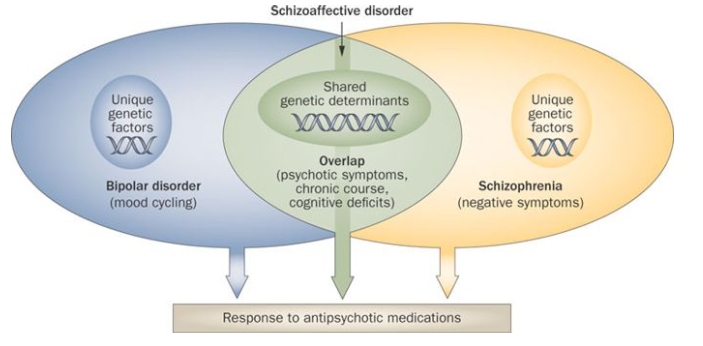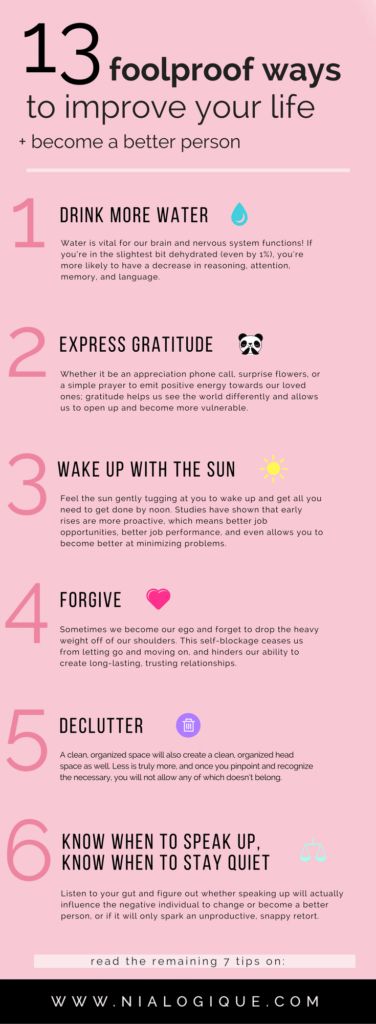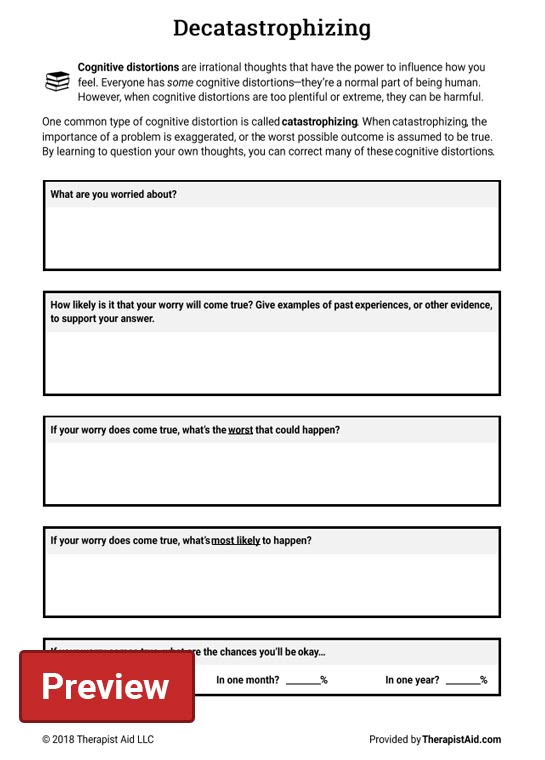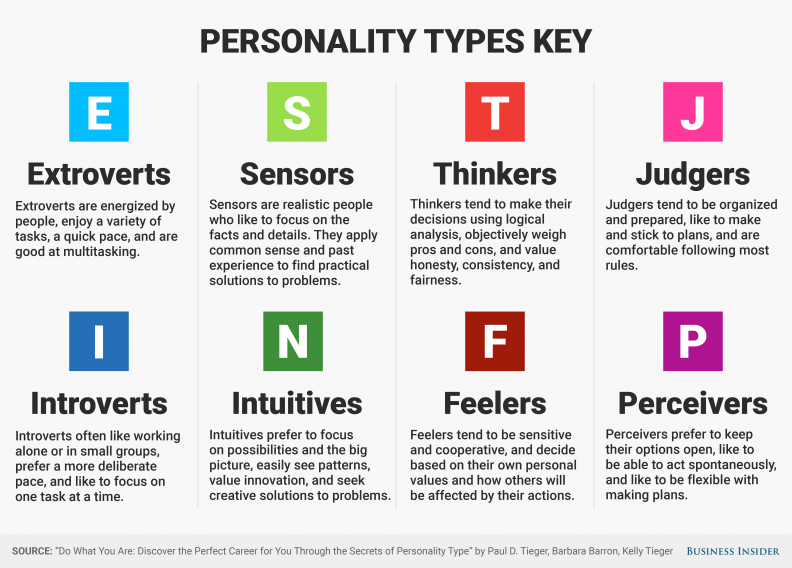Biofeedback therapy for panic attacks
Biofeedback for Anxiety: How It Works
Looking for alternative ways to manage anxiety? Biofeedback may help.
Anxiety is a natural part of the human experience that can keep you “on your toes” during important or stressful situations. For instance, feeling anxious about an upcoming event might help you prepare for or avoid challenges that may arise, resulting in a better outcome.
However, sometimes anxiety can cause challenges in daily functioning, especially if you have an anxiety disorder. Overwhelming fears and worries can impact:
- mental health
- physical well-being
- personal relationships
When anxiety creates challenges in daily life, finding strategies to feel more calm and less overwhelmed might be a priority for you. For some people, biofeedback can be a helpful option.
Biofeedback is a type of therapy that uses monitors and sensors to identify and control your body’s reactions to certain stimuli. It is designed to teach you how to manage your responses to things like stress and pain.
Biofeedback is generally considered safe for most people, with few reported negative side effects.
During a biofeedback session, a trained biofeedback therapist places sensors on your skin that monitor certain bodily functions, such as:
- heart rate
- breathing
- sweat output
- muscle movements and tension
- body temperature
- brain activity
Your biofeedback therapist reads the monitors and interprets how your body reacts to different stimuli. Based on this information, they may suggest ways to help you manage bodily responses using techniques such as:
- deep breathing
- guided imagery
- progressive muscle relaxation
Biofeedback sessions typically last 30-60 minutes, and a number of sessions are needed for biofeedback to be effective. Biofeedback is shown to be especially effective in conjunction with other typical forms of treatment for anxiety, and the number of sessions needed will depend on a variety of factors.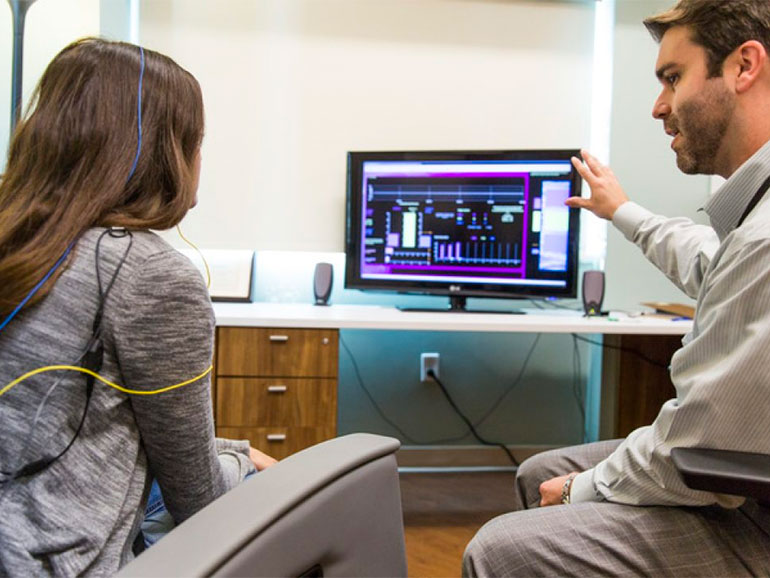
Once you have learned how your body responds to stress and ways to manage it, you will likely be given exercises to practice at home.
Types of biofeedback
Your biofeedback therapist may use one or more of several biofeedback methods available, depending on your wellness goals.
Different types of biofeedback include:
- Electromyography (EMG): monitors muscle response
- Respiratory biofeedback: records breathing and respiration rates
- Heart Rate (HR) biofeedback: registers heart rate, typically through a finger sensor
- Thermal biofeedback: uses sensors typically applied to your feet or fingers to detect body temperature changes
- Neurofeedback (EEG): monitors brain activity through sensors placed on your scalp
Biofeedback may be used as an alternative therapy for both physical and mental health issues for people who might not be comfortable using medications or invasive treatment options for certain conditions.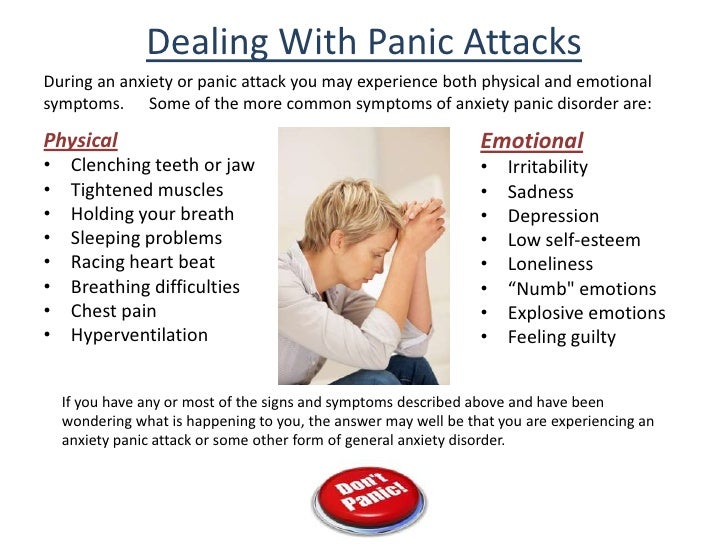 It may also be implemented alongside more mainstream treatments.
It may also be implemented alongside more mainstream treatments.
Biofeedback can be used for many mental and physical health conditions, such as:
- attention deficit hyperactivity disorder (ADHD)
- anxiety disorders
- chronic pain
- insomnia
- substance use disorders (SUD)
- high blood pressure (hypertension)
- asthma
Although research is limited, some studies suggest that biofeedback is effective in reducing anxiety symptoms.
For example, one research review published in 2017 suggests that, compared with no treatment, neurofeedback — which is a type of biofeedback — can improve symptoms of post-traumatic stress disorder (PTSD) and generalized anxiety disorder (GAD). It also found that supplementing treatment with biofeedback might be more beneficial and result in more rapid treatment gains than treatment without biofeedback.
Another 2017 article suggests that heart rate variability (HRV) biofeedback may reduce self-reported stress and anxiety. Therefore, it may be considered an effective treatment option for people experiencing symptoms of overwhelm and anxiety.
Therefore, it may be considered an effective treatment option for people experiencing symptoms of overwhelm and anxiety.
How can biofeedback help manage anxiety?
Biofeedback may offer ways to manage symptoms related to anxiety. For instance, you may not be aware of how your breathing patterns change during anxious moments. Biofeedback can detect those changes, and by practicing breathing exercises that change the pace or depth of your breathing, you may begin to feel less anxious, or feel that your anxiety is more manageable.
In addition, sometimes anxiety may not have an identifiable cause. Anxious feelings can often stem from worrying about an unknown outcome or feeling like you’re not in control of a situation.
Biofeedback may help you identify when you are becoming anxious, which can lead to a better understanding of what is causing your anxiety.
It might also help you learn how to manage your response to stressful stimuli, which may help you feel greater control in overwhelming, anxiety-producing situations.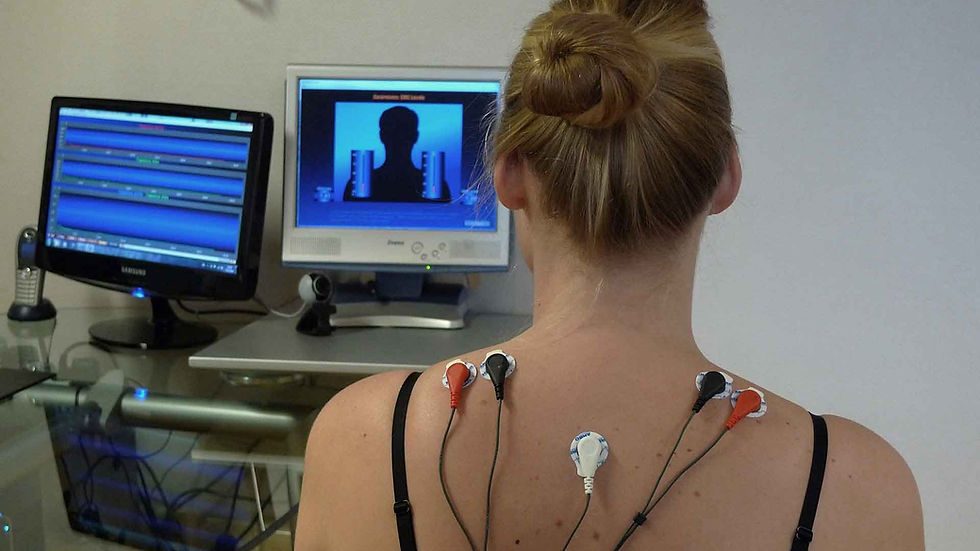
What types of biofeedback are useful for anxiety?
There are several types of biofeedback used to treat anxiety. You and a mental health professional will determine which is most appropriate to help you reach your wellness goals.
Types of biofeedback most often used for anxiety may include:
- electromyography (EMG)
- respiratory (breathing) biofeedback
- neurofeedback (EEG)
Although there are biofeedback devices designed for personal, at-home use, limited research exists on their effectiveness. Further, many devices have not had any independent research conducted. A 2018 critical review of wearable devices, apps, and other biofeedback equipment suggests buyers should carefully investigate such products before purchase.
Additionally, it’s important to understand that at-home devices are not connected to a trained professional who can accurately read and interpret the data collected.
Just like any treatment or therapy for anxiety, biofeedback has pros and cons. That’s why it can be a good idea to research methods and therapists who do biofeedback thoroughly before signing up for sessions.
That’s why it can be a good idea to research methods and therapists who do biofeedback thoroughly before signing up for sessions.
It may be a smart first step to speak with your doctor or therapist about biofeedback to determine if it could be right for you and your treatment plan.
Advantages of biofeedback may include:
- noninvasive
- relatively easy and brief to perform
- does not use medication, and can reduce the need for medication
- may help you feel more in control of your mental health
- can be done at home after OK’ed by a biofeedback therapist
Disadvantages of biofeedback may include:
- scientific research is limited on its effectiveness
- readings might be inaccurate for those who have health conditions such as a heart arrhythmia or certain skin conditions
- sessions can be time-consuming
- it may take several sessions to see improvements
- may not be covered by health insurance
One systematic review published in 2018 suggested that several challenges arose while using biofeedback for stress management.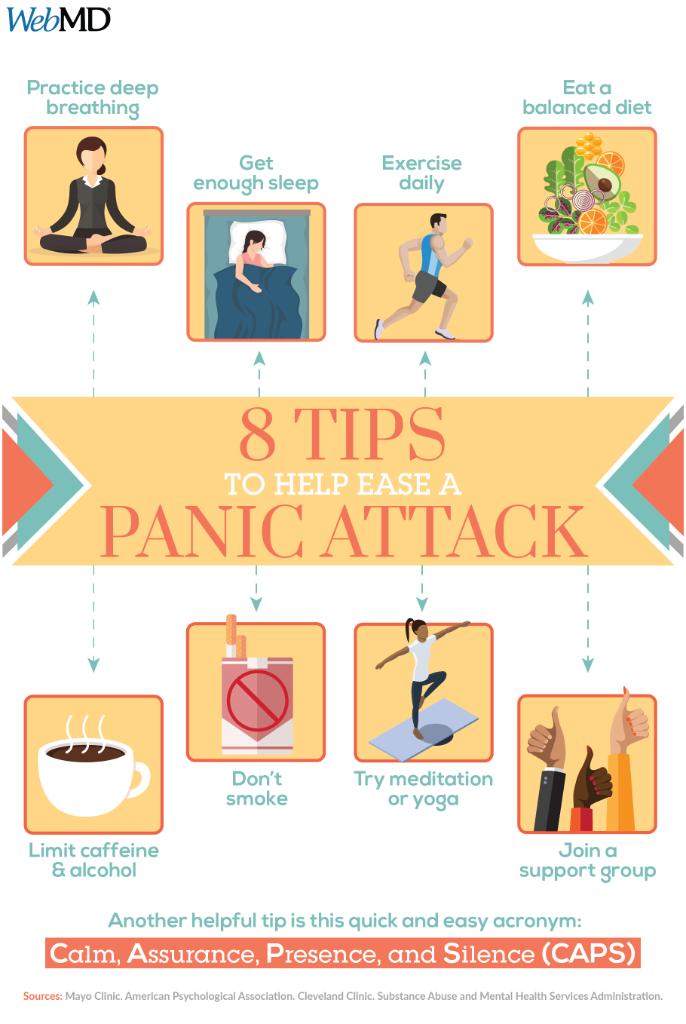 This review highlighted the importance of making improvements in user accessibility.
This review highlighted the importance of making improvements in user accessibility.
Biofeedback is noninvasive and may help you identify bodily response to anxious feelings as they arise, and provide you with tools to effectively manage symptoms in the moment.
Although there are several effective treatment options for anxiety, biofeedback can be a good option if you’re looking for alternatives to traditional methods. Oftentimes, biofeedback is used in addition to mainstream anxiety treatment options, like medication and therapy.
However, biofeedback is not for everyone, and scientists are still learning about the role biofeedback can play in treating anxiety.
If you are interested in exploring biofeedback for anxiety, speaking with your doctor or therapist is often the best first step. Like all therapies, you may have to try several types before you find an option that works best for you.
And if you need help finding a therapist, you can visit Psych Central’s guide on finding mental health support.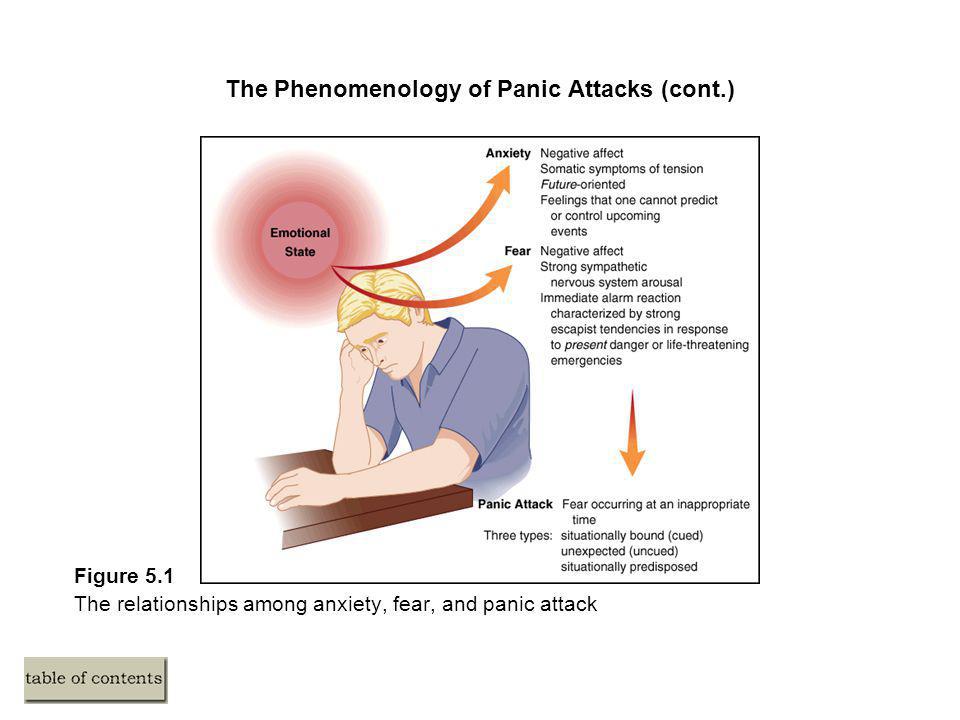
Biofeedback resources
To learn more about biofeedback for anxiety and connect with a therapist near you, visit:
- Association for Applied Psychophysiology and Biofeedback, Inc. (AAPB)
- International Society for Neuroregulation and Research (ISNR)
- Biofeedback Certification International Alliance (BCIA)
Biofeedback and Anxiety
By Alan Brauer, MD
Psychiatric TimesPsychiatric Times Vol 16 No 2Volume 16Issue 2
Considered a "fringe" therapy 25 years ago, biofeedback has matured today to a modality much closer to mainstream treatment. Its value is accepted by a growing number of professionals, and it is covered by Medicare for some conditions, as well as by most health insurers.
Considered a "fringe" therapy 25 years ago, biofeedback has matured today to a modality much closer to mainstream treatment. Its value is accepted by a growing number of professionals, and it is covered by Medicare for some conditions, as well as by most health insurers.
Applied psychophysiology has yet to fulfill early enthusiastic predictions of the benefits of learning and applying self-regulatory skills. However, the field has amassed sufficient research and clinical data to justify an important secondary role in treating a number of specific disorders. Fueled by advances in technology and increasing interest in alternative therapies, biofeedback remains a dynamic force that continues to tantalize with possible-though as yet unproved-applications.
Biofeedback, also referred to as applied psychophysiological feedback, is the process of displaying involuntary or subthreshold physiological processes, usually by electronic instrumentation, and learning to voluntarily influence those processes by making changes in cognition. It provides a visible and experiential demonstration of the mind-body connection. Biofeedback is also a therapeutic tool to facilitate learning self-regulation of autonomic functions for improving health.
In a quiet room, seated in a comfortable chair with sensors attached to the skin, the trainee (patient) views a monitor.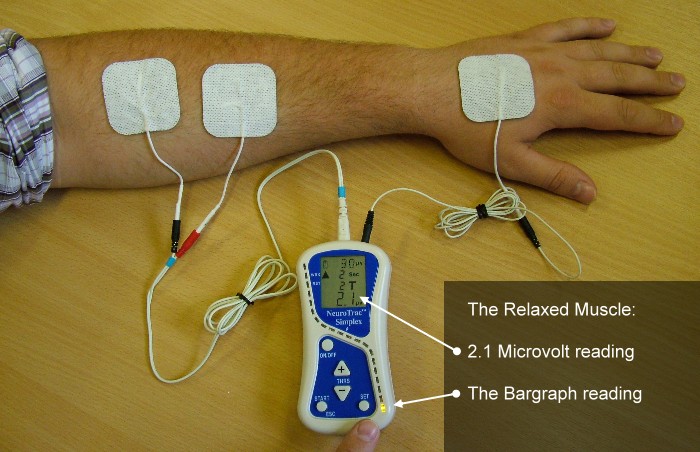 Advances in hardware and software technologies allow simultaneous monitoring of multiple modalities and the flexible shaping of visual and sound feedback to reinforce desired physiological states. Extensive data can be collected for immediate display with automatic storage for research.
Advances in hardware and software technologies allow simultaneous monitoring of multiple modalities and the flexible shaping of visual and sound feedback to reinforce desired physiological states. Extensive data can be collected for immediate display with automatic storage for research.
There are six commonly employed feedback modalities:
Electromyographic (EMG
): Frontalis, masseter, trapezius and sternocleidomastoid are the most frequently monitored sites.
Skin Conductance Level (SCL): Also referred to as Galvanic Skin Response (GSR). Finger electrodes register sweat gland activity.
Thermal: Finger thermistors measure vasoconstriction by minute changes in peripheral blood flow.
Respiratory: Strain gauges measure abdominal and thoracic excursions; a capnometer monitors exhaled CO2.
Heart Rate (HR): Finger photoplethysmography registers rate and pulse volume.
Brainwave/Neurofeedback (EEG): Multichannel equipment with more sophisticated software and new treatment protocols have replaced the simple single channel alpha training of earlier decades.
Biofeedback Applications
Used alone as relaxation therapy, biofeedback is as efficacious as other forms of relaxation training, such as hypnosis, progressive muscle relaxation or transcendental meditation. However, most applications of biofeedback are used as adjuncts to other types of therapy, treating physiological as well as psychological disorders.
Physiological disorders with credible research to support the ancillary use of biofeedback include headaches, chronic pain, rheumatoid arthritis, asthma, temporomandibular joint disorders, dysmenorrhea, epilepsy, hypertension, irritable bowel syndrome, intestinal motility, motion sickness, neuromuscular rehabilitation, Raynaud's disease and fecal incontinence (Crabtree et al., 1995; Schwartz, 1995).
Biofeedback also seems to be a useful tool in the treatment of a broad range of problems commonly seen by psychiatrists. The adjunctive use of biofeedback is reasonably well-documented for the psychological disorders of anxiety and insomnia.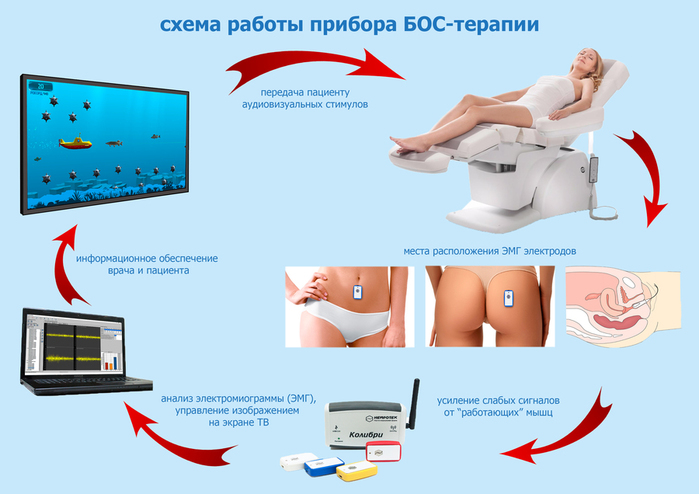 Many forms of psychotherapy, including dynamic, behavioral and brief, appear to have enhanced efficacy when biofeedback-assisted. Both the patient and therapist benefit from a display of physiological responses, which can help identify resistance, denial and other defense mechanisms. Biofeedback monitoring can provide a uniquely vivid demonstration of the connection between thoughts and feelings. Brain wave feedback is showing promise in the treatment of attention-deficit/hyperactivity disorder, addictive disorders and posttraumatic stress disorder (PTSD).
Many forms of psychotherapy, including dynamic, behavioral and brief, appear to have enhanced efficacy when biofeedback-assisted. Both the patient and therapist benefit from a display of physiological responses, which can help identify resistance, denial and other defense mechanisms. Biofeedback monitoring can provide a uniquely vivid demonstration of the connection between thoughts and feelings. Brain wave feedback is showing promise in the treatment of attention-deficit/hyperactivity disorder, addictive disorders and posttraumatic stress disorder (PTSD).
Biofeedback and GAD
Anxiety in some form is a problem that all psychiatrists must deal with on a daily basis. It is one of the most frequently observed categories of emotional disorders in the American population and often seriously interferes with the quality of everyday life. All of the anxiety disorders are defined by the dual characteristics of physiologic hyperarousal and excessive emotional fear.
Biofeedback has demonstrated value for hyperarousal reduction training in generalized anxiety disorder (GAD) and exposure desensitization in panic disorder (PD) and PTSD.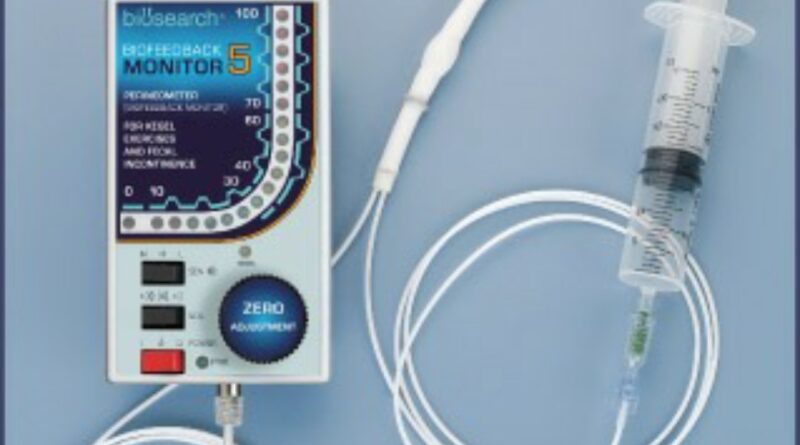
Multimodal cognitive/behavioral therapy (CBT), which may include biofeedback, offers an equally effective alternative to medications, particularly for patients who do not respond well, who have a potential for dependency or who refuse prescription drugs. Optimum treatment outcome for GAD and PD is more likely to be achieved with a combination of pharmacotherapy and CBT.
Biofeedback is one of the most useful adjuncts in treating physiologic hyperarousal-both episodic and chronic-seen in anxiety disorders. It has also proved helpful for patients who are learning to reduce fearful anticipation triggers through cognitive/behavior therapies.
Biofeedback training is a part of the behavioral treatment, which includes relaxation training, because of its additional specificity. Biofeedback offers a nonpharmacological approach to direct symptom reduction and can be tailored to the individual patient's psychophysiological profile. Those patients experiencing symptoms of muscle tension have EMG sensors attached to muscle sites showing the highest activity.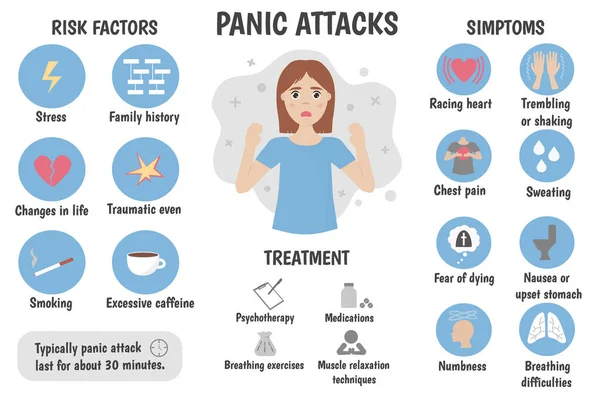 Patients with mainly autonomic symptoms generally receive thermal, GSR, heart rate and respiration feedback. EEG feedback may be useful when an assessment documents brain wave pattern dysregulation.
Patients with mainly autonomic symptoms generally receive thermal, GSR, heart rate and respiration feedback. EEG feedback may be useful when an assessment documents brain wave pattern dysregulation.
Behavioral treatment may also include cognitive interventions to identify negative thinking, and to develop more appropriate assessment of life events. Where specific fears can be identified, behavioral fear reduction techniques, such as desensitization, modeling or flooding, may be used. Concomitant use of biofeedback may enhance the therapeutic effectiveness of these techniques. Like most behavioral treatments, biofeedback is most effective with patients willing to assume an active role in the treatment process, including home practice.
Most studies document improvement and significant symptom reduction in six to 12 sessions of biofeedback training, with more complex or chronic patients requiring more sessions. For instance, in 1993 Rice et al. studied 45 GAD subjects (38 of whom met the DSM-III criteria). The study subjects were randomized to four treatment groups: frontal EMG biofeedback, EEG alpha enhancement biofeedback, EEG alpha suppression biofeedback or a pseudomeditation control. Results were compared against wait-list controls. All treated subjects showed significant reductions in STAI-Trait Anxiety and psychophysiological symptoms on the Psychosomatic Symptom Checklist. Decreased self-report of anxiety was maintained at six weeks posttreatment.
The study subjects were randomized to four treatment groups: frontal EMG biofeedback, EEG alpha enhancement biofeedback, EEG alpha suppression biofeedback or a pseudomeditation control. Results were compared against wait-list controls. All treated subjects showed significant reductions in STAI-Trait Anxiety and psychophysiological symptoms on the Psychosomatic Symptom Checklist. Decreased self-report of anxiety was maintained at six weeks posttreatment.
CBT, Biofeedback and Panic
David H. Barlow, Ph.D., developed a comprehensive model of panic disorder in which he explained that panics were sustained in patients because they developed a fear of bodily sensations associated with panic attacks (1988). Anxious apprehension causes chronic increased autonomic arousal, which increases vigilance with heightened sensitivity to evermore minute body sensations. A vicious cycle of apprehension and physiological activation results in panic disorder.
By allowing heightened internal awareness, low arousal relaxation training may actually precipitate increased anxiety in some patients with panic disorder. This relaxation-induced anxiety is less likely to occur with biofeedback than other general relaxation procedures.
This relaxation-induced anxiety is less likely to occur with biofeedback than other general relaxation procedures.
Diagnostic accuracy increases when biofeedback is used to monitor physiological reactions to questions about anxiety. EMG, SCL, HR, temperature and respiration are measured. The treatment of PD with CBT has four components, each of which may be more effective with biofeedback. Three focus on managing panic; the fourth aims to eliminate it.
Educational, Informational: Patients learn the causes of panic, the "fear of fear" cycle and the rationale for treatment. Various biofeedback modalities help in experiencing and understanding on a gut level the relationship between thoughts, feelings, images, bodily sensations and the actual body responses. "Biofeedback information seems to help patients 'get it' a lot faster," noted Hugh Baras, Ph.D., reporting on a study of biofeedback and panic disorder presented at the recent 24th Annual Conference of the Biofeedback Society of California in Monterey, Calif.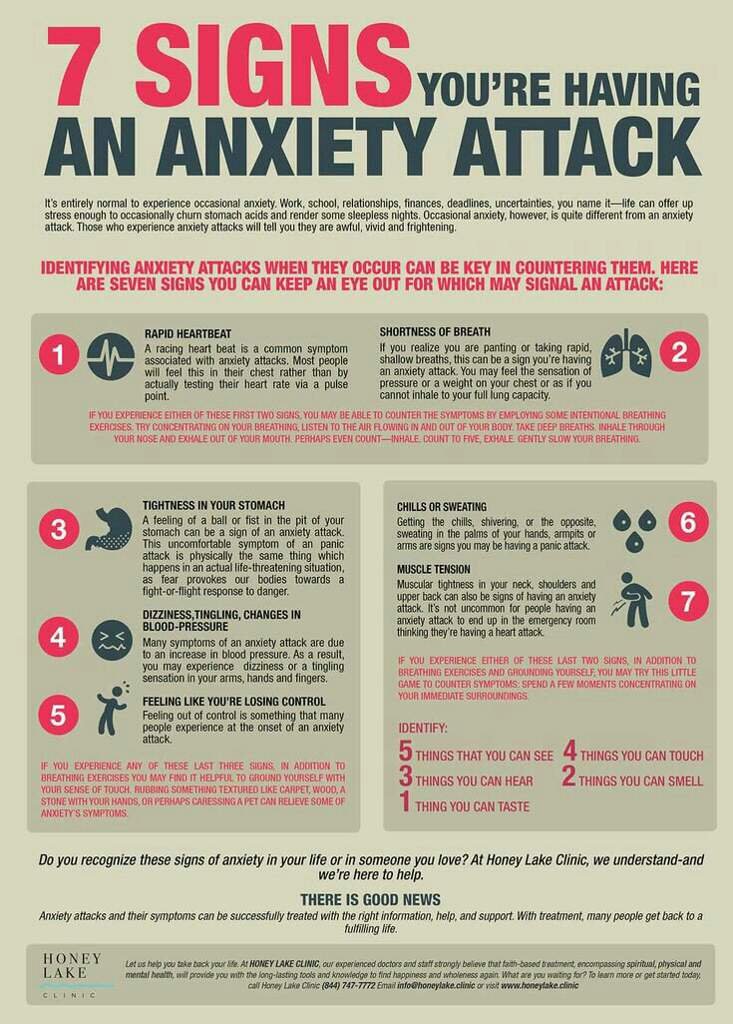
Somatic Management Strategies: Patients use these techniques to manage anxious apprehension. They include diaphragmatic breathing retraining, slow breathing and muscle relaxation. "Biofeedback-assisted breathing retraining and biofeedback-assisted muscle relaxation can be very helpful in providing motivation for patients and in providing the experience of mastery over their panic reactions," reported Baras.
Cognitive Restructuring: This technique provides instruction and practice in constructive self-talk to reduce fears of anxiety sensations. Exaggerated fears of somatic symptoms or the probability of negative reactions and adverse outcomes are replaced with more realistic attitudes. Trainees are often surprised to see the biofeedback equipment demonstrate a striking difference between the responses from their fearful thoughts as compared to responses as a result of their restructured thoughts.
Fear Exposure Strategies: The aim of these strategies is to eliminate the experience of panic.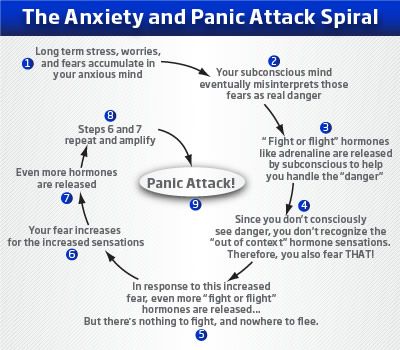 They are also the nonpharmacological treatment of choice for specific phobias, including agoraphobia and obsessive-compulsive disorder. In a systematic and controlled way, exposure therapy elicits the physical sensations that trigger anxiety. The goal-fear extinction-is to break the associations between increased body sensations and panic reactions. There are two types of fear exposure:
They are also the nonpharmacological treatment of choice for specific phobias, including agoraphobia and obsessive-compulsive disorder. In a systematic and controlled way, exposure therapy elicits the physical sensations that trigger anxiety. The goal-fear extinction-is to break the associations between increased body sensations and panic reactions. There are two types of fear exposure:
1. Brief and graduated (systematic desensitization): The arousal-provoking event is presented for about a minute, spaced with intervals of relaxation. The intensity of arousal is gradually increased, creating the experience of anxiety mastery.
2. Prolonged and intense (flooding): Ten to 15 minutes of repeated exposure to maximal intensity stimulus demonstrates to the patient that the feared negative consequences do not occur. This results in fear extinction. Exercises to help induce flooding include rapid head movements, breath holding, restricted breathing, hyperventilation and muscle tensing.
Substantial research data support the value of using cognitive restructuring and fear exposure in preventing relapse. Like a pilot turning on the radar, exposure therapy is more effective when therapist and patient have immediate autonomic feedback to guide the process. The advantages of biofeedback-assisted CBT for PD include increased awareness and control of the stress response, increased motivation for treatment and willingness to practice home assignments, and heightened self-confidence.
Biofeedback for Children
There are several controlled studies showing the efficacy of using biofeedback to reduce anxiety in children. In 1996, Wenck et al. studied 150 seventh- and eighth-graders identified as anxious by their teachers. The students were randomly assigned to biofeedback intervention, which included six sessions each of EMG and thermal biofeedback, or control groups. The researchers found that the biofeedback group had significantly lower posttest states and trait anxiety.
Referrals and Certification
Biofeedback therapy is commonly performed by clinical psychologists, or by a biofeedback trainer under the direct supervision of a psychologist or psychiatrist. The Biofeedback Certification Institute of America has a written/practicum certification process. The Association for Applied Psychophysiology and Biofeedback in Wheat Ridge, Colo., sponsors an annual conference and provides information and referrals. Larger states have biofeedback societies for local referrals.
References:
References
1.
Barlow DH (1988), Anxiety and Its Disorders: The Nature and Treatment of Anxiety and Panic. New York: Guilford Press.
2.
Crabtree M, Kase J, Bland A et al. (1995), An Annotated Bibliography on Clinical Applications of Biofeedback and Applied Psychophysiology. Wheat Ridge, Colo.: Association for Applied Psychophysiology and Biofeedback.
3.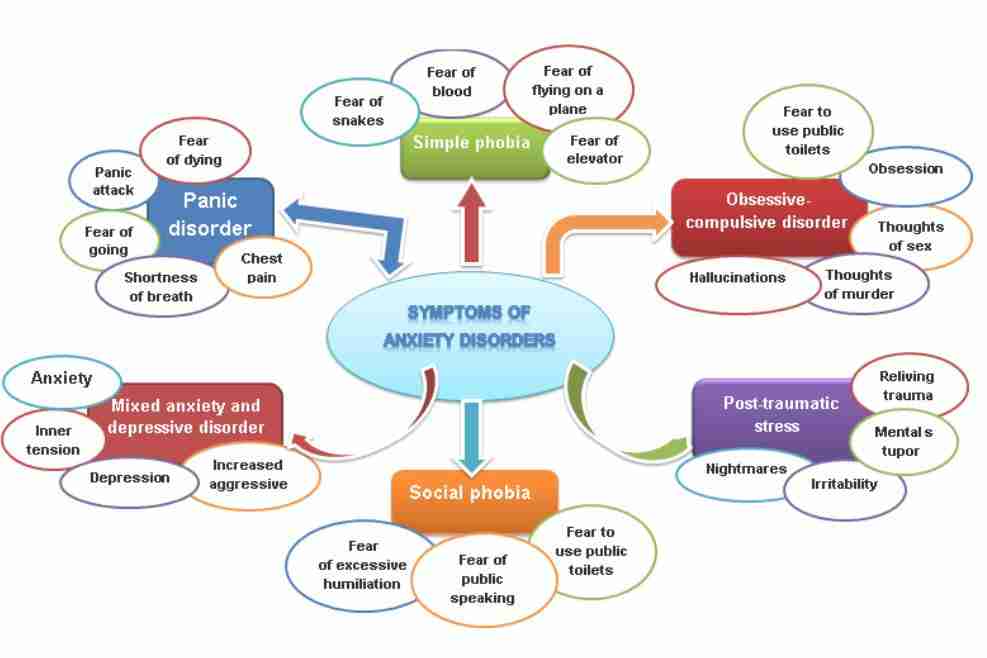
Rice KM, Blanchard EB, Purcell M (1993), Biofeedback treatments of generalized anxiety disorder: preliminary results. Biofeedback Self Regul 18(2):93-105.
4.
Schwartz MS (1995), Biofeedback: A Practitioner's Guide. New York: Guilford Press.
5.
Wenck LS, Leu PW, D'Amato RC (1996), Evaluating the efficacy of a biofeedback intervention to reduce children's anxiety. J Clin Psychol 52(4):469-473.
Panic attacks. Whom to contact and how a neurologist can help?
Over the past 2 years, much has changed in the life of all mankind. We have to adapt to new, sometimes very difficult, conditions. From TV and the Internet, we are constantly pressed with disturbing news and not the best forecasts, or the unknown in the future.
Someone copes with this easily and is ready for change, while someone falls into a state of panic and cannot do anything about it. The normal reaction of people when faced with the difficulties of life is to try to understand what is happening and what to do with it next.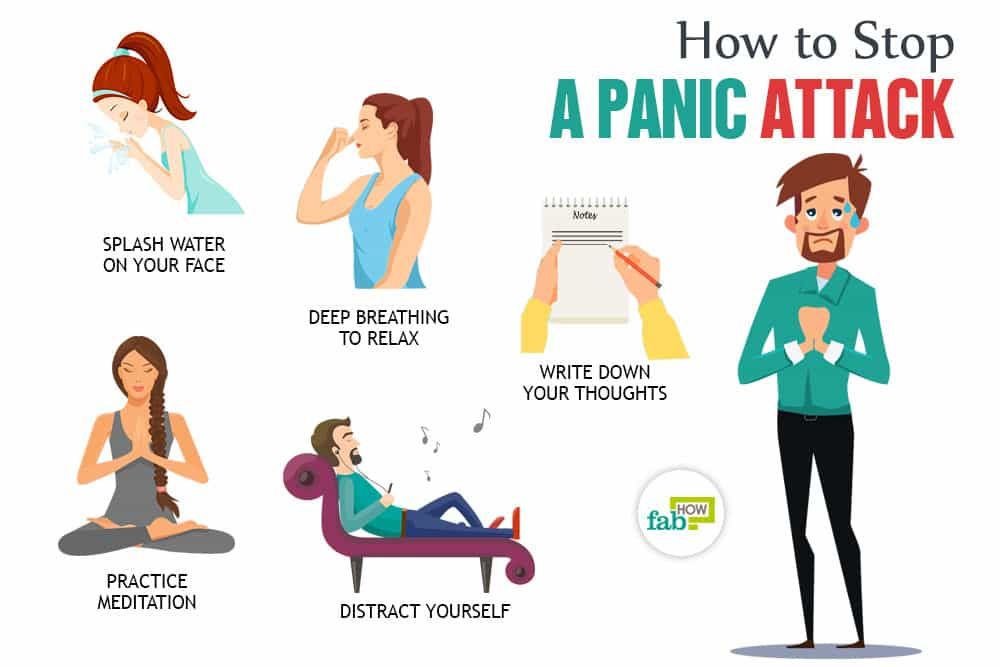 nine0003
nine0003
Our body is a mirror of our mental state and reflects these problems in the form of symptoms that are difficult to distinguish from serious diseases of organic origin.
On one not the best day, a person is faced with a new condition for himself and begins to suspect that has covered him with a panic attack . Let's figure out what it is, how to survive this state and not go crazy (despite the fact that before that you clearly controlled everything in life) and what strategy to develop in order to emerge victorious from this situation. nine0003
Panic attack (panic) is a short-term episode of intense anxiety with a sudden onset, reaching a maximum within a few minutes, accompanied by anxiety or fear of death, loss of control, combined with severe disturbances in the work of the heart, respiratory system, gastrointestinal tract.
If this condition begins to recur (with the symptoms may vary slightly), then doctors are already talking about panic disorder or episodic paroxysmal anxiety . Unfortunately, the patient quickly develops a fear of waiting for an attack.
Unfortunately, the patient quickly develops a fear of waiting for an attack.
Signs of a panic attack
-
Heart . The characteristic onset of an attack is accompanied by symptoms from the cardiovascular system - with a sudden onset of a "strong heartbeat", a feeling of "interruptions", "stop", discomfort or pain in the region of the heart.
- nine0002 Pressure . Most panic attacks are accompanied by a rise in blood pressure, the numbers of which can be quite high.
-
Choking . The most pronounced violations in the respiratory system: shortness of breath, a feeling of lack of air with shortness of breath and hyperventilation, "a feeling of suffocation." Describing an attack, patients report that they “caught their throat”, “the air stopped flowing”, “it became stuffy”. nine0003
-
Indigestion . Gastrointestinal disturbances such as nausea, vomiting, belching, epigastric discomfort, feeling of fullness or abdominal pain may also be observed.
 As a rule, at the time of a panic attack, dizziness, sweating, tremor with a feeling of chills, “waves” of heat and cold, paresthesia, coldness of the hands and feet are observed.
As a rule, at the time of a panic attack, dizziness, sweating, tremor with a feeling of chills, “waves” of heat and cold, paresthesia, coldness of the hands and feet are observed. -
Appearance . Changes in complexion, pulse rate, fluctuations in blood pressure are objectively determined, and dissociation is often found between the subjective experience of autonomic disorders by patients and their severity during an objective examination.
The disease can develop slowly, over months or years, or it can develop quickly, over days or weeks.
As panic attacks continue, they can be associated with various life circumstances, which become, as it were, conditioned stimuli. Attacks can be repeated in similar situations in which the attack occurred for the first time (metro, transport, loneliness), fear is formed in anticipation of an attack. nine0003
How can you help yourself with a panic attack?
- Analyze the situation .
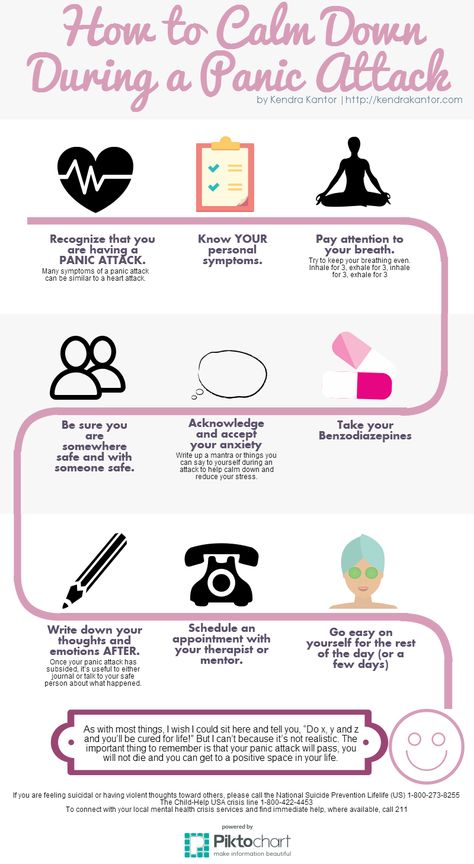 If you have the above symptoms, you must first determine whether this is a panic attack as a one-time occurrence against the background of stress (illness) or there is a fixation of panic and you will clearly need medical help.
If you have the above symptoms, you must first determine whether this is a panic attack as a one-time occurrence against the background of stress (illness) or there is a fixation of panic and you will clearly need medical help. - Focus on your breath . Remember that the first first aid is to go out into the air, deeply and consciously begin to breathe. If there is no way to walk, then just lie down, take a comfortable position, breathe deeply and slowly. nine0030
- Don't be alone . Do not hesitate to ask for help from those who are nearby, do not hide your condition. Discuss what happened. Don't be alone with the problem!
- Make an appointment with a doctor . If the episodes recur, a doctor can help resolve the problem. Before taking, think about the circumstances under which seizures occur. These can be:
- viewing disturbing news;
- conversation with a friend, quarrel with relatives; nine0030
- situation at work with colleagues;
- study exam;
- watching movies;
- a trip in public transport, in an elevator, etc.
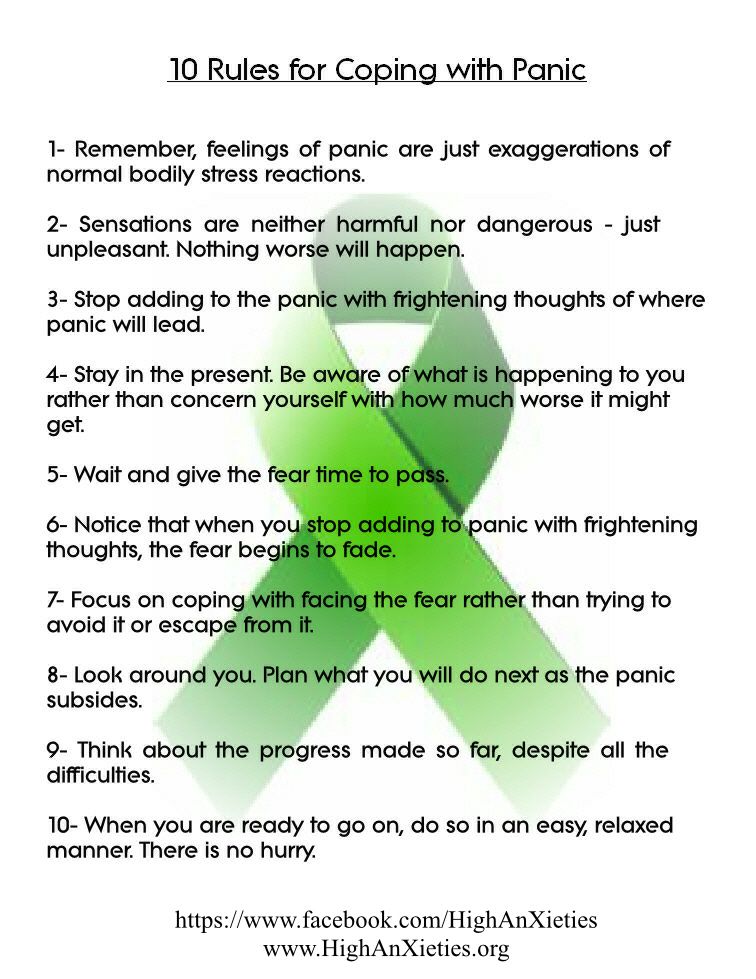 ).
).
Panic attack treatment by a neurologist
Many people ask the question: how and how can a neurologist help me? It's forever. Nothing like this! It is a myth. Panic attacks are very well treated. If you think about it, it's time to contact a neurologist and strictly follow his recommendations. nine0097
- The doctor will examine you,
- will conduct tests,
- listens carefully, asks specific questions,
- will match the symptoms and facts of your life,
- will prescribe a basic treatment that will immediately start working.
- If necessary, will prescribe additional examinations.
The doctor will tell you how to act in your individual situation!
- If at the appointment he reveals violations of the cardiovascular system that are clearly permanent in nature, he will refer you to a cardiologist, for an ECG, for monitoring heart rate (Holter). This is necessary to determine if there is a pathology of the heart and whether it is necessary to take control of the heart rhythm and heart rate with medication.
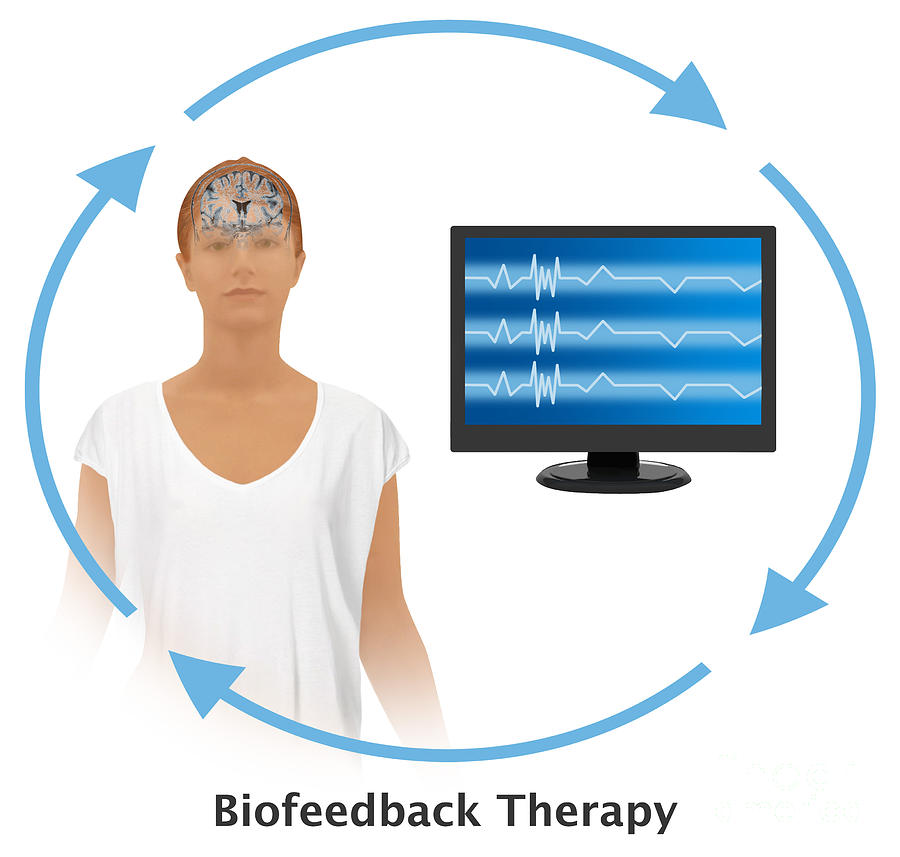
- If the doctor suspects panic attacks on the background of hypertension (high blood pressure), then he will refer to ABPM and pressure adjustment.
nine0025 If he reveals a permanent psycho-traumatic situation (as the cause of the development of panic attacks), which can be removed with the help of psychotherapeutic techniques, he will give a referral to a psychotherapist.- If the leading symptom is a violation of the gastrointestinal tract, then together with a gastroenterologist, he will remove unpleasant symptoms, find out what hidden chronic disorders the patient has (they are the most pronounced during a panic attack).
nine0079At the follow-up appointment, the neurologist, as the treating doctor of a patient with panic attacks, will analyze all the research results, adjust the treatment, dosages of drugs, help the patient develop a behavior strategy and form an adaptive thinking pattern. After a short time, you will forget about panic attacks.

I wish you a speedy recovery and a happy life of a healthy and panic free person. Come!
Panic attacks
Panic attacks (episodic paroxysmal anxiety) - attacks of severe anxiety (panic) or fear (most often - fear of death, less often - fear of losing consciousness, loss of control, helplessness or fear of "going crazy"), accompanied by a rapid heartbeat and a feeling of " suffocation, shortness of breath. Sometimes there are additional symptoms such as increased blood pressure, a feeling of "internal trembling", trembling in the limbs, a feeling of "hot flashes" of heat or cold, numbness of the extremities, increased sweating, a feeling of "unstability" or dizziness, nausea, derealization or depersonalization, etc. nine0003
Panic attacks last on average 5 to 30 minutes. However, sometimes they can last several hours, and in rare cases - up to several days.
I must say that even 30 years ago this disease was extremely rare. But now the incidence of panic attacks is increasing exponentially every year! Especially in big cities.
Alas, panic attacks are considered a “disease of megacities”. And they suffer, most often, people with increased anxiety and the so-called perfectionists. nine0003
Earlier, in Soviet medicine, this disorder was called " sympathoadrenal crises ". This name, more than the modern one, reflected the essence of the processes occurring in the body during panic attacks. Nevertheless, I will not bother readers with a description of biochemical processes and a list of the hormones and neurotransmitters involved in these reactions. Knowing this practically does not affect the fact of the occurrence of seizures. Because biochemical processes are just an "intermediate link" in the chain of cause and effect relationships occurrence of panic attacks . What then is the "primary link", so to speak, the root cause?
Panic attacks occur suddenly, and, as it often seems, without any external causes or under the influence of minor unpleasant factors (an ordinary quarrel in the family, another trouble at work, overcrowding and stuffiness in a subway or train car, a long “traffic jam” on the road, etc.
). etc.). In fact, panic attacks always occur against the background of an already long-term depression (most common), or after repeated or severe stress (or rather, distress). Don't be surprised by this, because it is quite difficult for an ordinary person, not a specialist, to diagnose depression. Especially, at himself. Moreover, its mild or atypical forms. Especially if it lasts a year or several years (and for some people - since childhood!). In this case, they may not even remember how they felt without depression. In this variant, the body functions “with the last of its strength”, works “at the limit of its capabilities”; and some minor unpleasant event can be the “last straw” for him! nine0009 Figuratively speaking, a panic attack is “hysteria of the body”, its “desperate cry: “I can’t do this anymore !!!”
Well, in the question "Who is to blame?" figured it out. Now let's move on to the equally important question "What to do?" The fact that no one in the world has yet died from panic attacks is little consolation for those suffering from this excruciating disorder.
To say that panic attacks are an unpleasant state is an understatement! These are unbearable sensations, and in the most severe cases, a real feeling of approaching death, which a person is sometimes forced to experience daily! And most importantly, he does not understand what is happening to him, and how to stop it! nine0003
Panic attacks sharply reduce the quality of a person's life, subordinating her entire expectation of the next attack. And, accordingly, they affect social activity, sometimes making a person completely incapacitated.
When panic attacks first appeared in the clinical practice of physicians, they were treated empirically with various sedatives and tranquilizers. However, after their cancellation, the seizures reappeared, and with prolonged use of these drugs, tolerance (insensitivity) inevitably and rather quickly set in. Therefore, in order to stop panic attacks, it was necessary to constantly increase doses or resort to more “strong” tranquilizers.
But everywhere there is a limit: the number of tranquilizers is not unlimited, especially their doses. It was necessary to remember another very important aspect: long-term use of these drugs causes dependence on them. And after the abolition of tranquilizers, the symptoms of mental and physical withdrawal joined the renewed panic attacks, which further worsened the patient's condition. nine0003
Then the tactics of treatment were somewhat changed: antidepressants were added to "light" or small doses of "medium-powered" tranquilizers. And it was a "breakthrough" in the treatment of panic attacks! Because antidepressants do not just "relieve" the symptoms, but they affect the foundation on which these attacks are based - depression itself! Of course, in modern medicine there are a huge number of antidepressants, and the effectiveness of their effect on panic attacks is very different. But an experienced psychotherapist or psychiatrist can quite accurately select a drug that is suitable for a particular person.
It is important to note that antidepressants have a cumulative effect, so their therapeutic effect does not appear immediately after the appointment, but after a certain time (on average, after a month). And, here, the full duration of treatment with antidepressants is, at best, from 6 to 12 months, and sometimes up to several years. nine0003
At the same time, there are cases of especially severe courses of panic attacks, when the appointment of even "powerful" antidepressants for a sufficiently long time does not bring the desired effect, i.e. panic attacks do not stop completely, but only become less pronounced or occur less frequently. In this version, a person, anyway, does not feel healthy and constantly lives in fear of the next attack. In this case, doctors are forced to launch "heavy artillery" - to add NEUROLEPTICS to the treatment, which patients have to take for quite a long time. Antipsychotics have a large number of unpleasant side effects, which is why many patients refuse them.
nine0003
However, there is another way to treat panic attacks. He is not a drug! That is, there is a REAL METHOD OF COMPLETE CURING FROM PANIC ATTACKS, ABSOLUTELY WITHOUT RESORTING TO ANY KIND OF MEDICINES !!! This method is PSYCHOTHERAPEUTIC.
In the modern world there are a lot of different types and directions of psychotherapy. But, it must be said bluntly that with panic attacks, most of them are not effective without medical support. nine0003
However, the method that I use in my psychotherapeutic work is unique. It often allows you to completely eliminate panic attacks in 1 session! One or two more sessions are required to eliminate the FEAR of the appearance of seizures (or their expectation).
But in order to begin the direct elimination of panic attacks, a certain “intellectual” preparation of the patient is necessary. It requires from 8 to 12 sessions (depending on the severity of the disease and the personal characteristics of the patient) with a frequency of 1-2 sessions per week.

